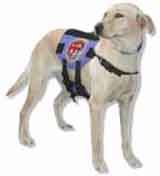Dog Behavior Problems and TrainingHyperkinesis In Dogs |
|
|
Anyone who has worked extensively with dogs has occasionally been confronted by an over-active, sometimes raging, vicious kind of dog, the handling of which has required a heavy duty tranquilizer and several helpers. In many cases, such behavior cannot be explained by improper handling or cruelty and neglect by their owners. When it seems that nothing can be done to correct the problem, then he is written off as "just a plain vicious dog" and relegated to the end of a chain or destroyed as a menace to the neighborhood. Since the early 1970s, such excitable and mean behavior has been identified in some dogs as hyperkinesis. Hyperkinesis is a behavioral condition that is described as "a hyper behavior that is treatable with stimulants." by Bonnie V. Beaver, in The Veterinarian's Encyclopedia of Animal Behavior. Lack of accurate information from dog owners exists regarding this condition, probably because it has recently been given a new label which is "attention deficit disorder." While ADD, as it is termed, may describe certain aspects of the readily observable behavior of a hyperkinetic dog, it lacks the physiologic symptoms which can be described and measured. Signs associated with hyperkinesis in dogs are usually displayed when the dog is stressed by close confinement and/or social isolation. Signs include rapid heart rate and respiration, excessive salivation, a high metabolic rate, and reduced urine output. The major difficulty in identifying the syndrome, however, is that there is no apparent cause. Clinical signs may be evident in dogs that are normal in other circumstances. In addition, dogs identified as hyperkinetic do not always exhibit the same behavior patterns or physical symptoms. Initial symptoms of this problem falls into the following categories: the dog cannot sit still, even for a minute; he never becomes accustomed to everyday situations; he cannot be taught anything (often an obedience school failure); and he salivates constantly and always seems very excited or very nervous. Many experienced, gentle dog owners were bitten, and some of these dogs will viciously attacked other dogs without hesitation, even friendly and docile animals. In studies designed to evaluate responses to stress, some dogs did not respond to positive reinforcement, and tranquilization were all tried, but did not work. Typically, such dogs would be eliminated from the study, but because the researchers were interested in the interaction of genetics and psychological environment, they were curious about dogs that appeared unwilling to be studied. Eventually the researchers decided they were dealing with the equivalent of hyperkinetic children.Back to the Dog Behavior Problems and Training page
| |
|
Related News About Dogs ' ); // get rid of newsfeed display by carp CarpConf('poweredby',''); CarpCacheShow('http://dogguidance.com/dogblog/?feed=rss2'); ?>
|
|
|
|
|
|
Copyright © 2006-2007 dogguidance.com |


